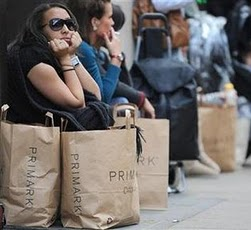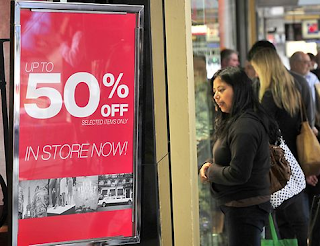 The stock market was inspired by what appears to be a constructive European action and better than expected GDP growth for Q3, but the consumer mood, of which we received three measurements last week, still spells trouble.
The stock market was inspired by what appears to be a constructive European action and better than expected GDP growth for Q3, but the consumer mood, of which we received three measurements last week, still spells trouble. Our founder earned clients a 23% average annual return over five years as a stock analyst on Wall Street. "The Greek" has written for institutional newsletters, Businessweek, Real Money, Seeking Alpha and others, while also appearing across TV and radio. While writing for Wall Street Greek, Mr. Kaminis presciently warned of the financial crisis.
Our founder earned clients a 23% average annual return over five years as a stock analyst on Wall Street. "The Greek" has written for institutional newsletters, Businessweek, Real Money, Seeking Alpha and others, while also appearing across TV and radio. While writing for Wall Street Greek, Mr. Kaminis presciently warned of the financial crisis.Relevant Tickers: NYSE: XRT, NYSE: WMT, NYSE: PIR, NYSE: ETH, Nasdaq: HOFT, NYSE: HD, NYSE: LOW, Nasdaq: AAPL, NYSE: BBY, NYSE: LTD, NYSE: CHS, NYSE: ANN, NYSE: GPS, NYSE: M, NYSE: JCP, NYSE: JWN, NYSE: TJX, NYSE: KSS, Nasdaq: COST, NYSE: TGT, NYSE: WMT, Nasdaq: WTSLA, Nasdaq: HOTT, NYSE: AEO, NYSE: ARO, NYSE: ANF, NYSE: SAK, NYSE: TIF, NYSE: TLB, NYSE: LL, Nasdaq: BLDR, NYSE: FO, NYSE: LEG, NYSE: TPX, NYSE: AYI, NYSE: LZB, Nasdaq: SCSS, NYSE: ZZ, NYSE: FBN, NYSE: NTZ, Nasdaq: SHLD, NYSE: DDS, Nasdaq: BONT, Nasdaq: CPWM, Nasdaq: BKRS, Nasdaq: BEBE, NYSE: BKE, Nasdaq: CACH, Nasdaq: CMRG, Nasdaq: CATO, NYSE: CBK, Nasdaq: CTRN, NYSE: PSS, Nasdaq: DEST, Nasdaq: DBRN, NYSE: DSW, Nasdaq: FINL, NYSE: FL, Nasdaq: GYMB, NYSE: GES, NYSE: JCG, NYSE: JNY, Nasdaq: JOSB, NYSE: NWY, NYSE: JWN, NYSE: MW, Nasdaq: SYMS, Nasdaq: PLCE.
Consumer Wisdom Disagrees with Market Speculation
The Dow Jones Industrials Index was up 3.1% from the close of trading Wednesday through the conclusion of the week. The catalyst was of course the announcement of the planned action in Europe to resolve the Greek debt crisis and to solidify European banks moving forward.
Solid economic results here at home helped the market along as well. GDP was reported up 2.5% for the third quarter, marking a significantly more robust rate of growth than the second quarter’s 1.3% struggle; though GDP benefited from a deteriorated U.S. savings rate. Durable Goods Orders, ex-transportation, were reported up 1.7% in September. On Friday, Personal Outlays (spending) was noted up 0.6% in September, exceeding expectations for a 0.3% increase; though it benefited some from higher prices. Still, the news was mostly perceived to be relatively strong across important economic metrics, and it supported the market’s burst on the European fix.
All that said and done, we received three measures of the consumer mood last week, and none reflected the nascent enthusiasm of stocks. Of course, the measurements were all taken ahead of the news breaks of the week’s catalysts. Still, how much better off are consumers today versus when they were surveyed? I suspect they are still knee deep in it. Furthermore, it’s my belief that Europe might yet implode, and if it does not, it still faces a struggle. In the States, I’ve already outlined the flaws of the economic drivers, and call attention to a still burdensome unemployment rate, unfair trade environment and handicapped capitol. Let’s not forget the rising tide of civil unrest. By the way, did you know Wall Street Greek
warned about civil unrest in the U.S. well before the first few protestors gathered in Manhattan?
As far as American consumers see it, the economic situation remains troubled. I’m inclined to believe their opinion more than the speculative market that drove stock prices higher Thursday but failed to build upon the move Friday. Furthermore, too many high flying and recently reliable companies are warning about the road ahead if not failing to satisfy today, with Apple (Nasdaq: AAPL), Netflix (Nasdaq: NFLX), Cree (Nasdaq: CREE), eBay (Nasdaq: EBAY), VMware (NYSE: VMW), Amazon.com (Nasdaq: AMZN) and IBM (NYSE: IBM) letting shareholders down in one way or another this quarter. And while some investors may have forgotten this important fact last week, I remembered that the last Challenger Jobs Report showed a
significant number of announced corporate layoffs, and that unemployment and economic growth seemed more likely to deteriorate than to improve based on Goldman Sachs (NYSE: GS) and other economists’ updates of the last several weeks.
Consumers are feeling ill; there’s no doubt about that. Early last week, the Conference Board reported its
Consumer Confidence Index dropped dramatically in October, to a mark of 39.8, from a poor base of 46.4 in September. The main components of the index, which comprise the views of the present situation and expectations for the next six months, declined in union. The consumers’ view of the present situation was simply horrible, with the representative index down to 26.3, from 33.3. The Expectations Index collapsed to 48.7, from 55.1, clearly illustrating lost hope. According to Lynn Franco, Director of The Conference Board Consumer Research Center, "Consumer confidence is now back to levels last seen during the 2008-2009 recession.”
Bloomberg reports its
Consumer Comfort Index weekly, so it offers a very relevant and fresh view of the consumer mood. Bloomberg’s index fell to minus 51.1 in the week ending October 23, from negative 48.4 the week before. Not only was it the worst reading in a month, but it reflected levels not seen since the Great Recession, which we are supposed by many to have recovered from. Do you notice a recurring theme here yet?
On Friday, the University of Michigan, in conjunction with Thomson Reuters, reported its
Consumer Sentiment Index for the close of October. This measure varied from the other two in that it projected improvement. The Michigan Index gained to 60.9, from a sour 57.5 mark at the start of the month. However, it was only up slightly against September’s close, when the index measured at 59.4. The current situation component of this index improved slightly to 75.1, from 74.9, but that’s a negligible change. What was telling was what happened in the expectations component of the index. It improved, yes, to 51.8 from 49.4. However, it improved from a near 30-year low, which was marked at the start of the month. The point is that while the expectations index showed improvement, it was from a historical trough, and those expectations remain at a point reflecting very tough times.
The measures these indexes produce should not be given too much weight for their direction, whether they show improvement or deterioration, but they should be watched closely for absolute value, trend and magnitude of change. The trend of course depicts a more meaningful direction than one month’s change, and the magnitude of change, given a margin of error, matters more than slight directional movements. Of course, the absolute value of all three indexes was poor, despite the differences of the three. What I see in these indexes is a situation that still spells trouble, and given the distance Europe must yet travel to truly survive its crisis, and the soft or tangential drivers of U.S. economic data improvement, I think consumers are wiser today than the market was for one day last week.
Article interests investors in: S&P Retail ETF (NYSE: XRT), Wal-Mart (NYSE: WMT), Pier 1 Imports (NYSE: PIR), Ethan Allen (NYSE: ETH), Hooker Furniture (Nasdaq: HOFT), Home Depot (NYSE: HD), Lowes (NYSE: LOW), Apple (Nasdaq: AAPL), Best Buy (NYSE: BBY), The Limited (NYSE: LTD), Chicos (NYSE: CHS), Ann Taylor (NYSE: ANN), The Gap (NYSE: GPS), Macy’s (NYSE: M), JC Penney (NYSE: JCP), Nordstrom (NYSE: JWN), TJX Company (NYSE: TJX), Kohls (NYSE: KSS), Costco (Nasdaq: COST), Target (NYSE: TGT), Wet Seal (Nasdaq: WTSLA), Hot Topic (Nasdaq: HOTT), American Eagle Outfitters (NYSE: AEO), Aeropostale (NYSE: ARO), Abercrombie & Fitch (NYSE: ANF), Saks (NYSE: SAK), Tiffany (NYSE: TIF), Talbots (NYSE: TLB), Lumber Liquidators (NYSE: LL), Builders Firstsource (Nasdaq: BLDR), Fortune Brands (NYSE: FO), Leggett & Platt (NYSE: LEG), Tempur-Pedic International (NYSE: TPX), Acuity Brands (NYSE: AYI), La-Z-Boy (NYSE: LZB), Select Comfort (Nasdaq: SCSS), Sleepy’s (NYSE: ZZ), Furniture Brands (NYSE: FBN), Natuzzi (NYSE: NTZ), Sears (Nasdaq: SHLD), Dillard’s (NYSE: DDS), Bon-Ton (Nasdaq: BONT), Cost Plus (Nasdaq: CPWM), Baker’s Footwear (Nasdaq: BKRS.OB), Bebe Stores (Nasdaq: BEBE), The Buckle (NYSE: BKE), Cache (Nasdaq: CACH), Casual Male (Nasdaq: CMRG), Cato (Nasdaq: CATO), Christopher & Banks (NYSE: CBK), Citi Trends (Nasdaq: CTRN), Collective Brands (NYSE: PSS), Destination Maternity (Nasdaq: DEST), Dress Barn (Nasdaq: DBRN), DSW (NYSE: DSW), Finish Line (Nasdaq: FINL), Footlocker (NYSE: FL), Gymboree (Nasdaq: GYMB), Guess (NYSE: GES), J. Crew (NYSE: JCG), Jones New York (NYSE: JNY), Jos. A Banks (Nasdaq: JOSB), New York & Co. (NYSE: NWY), Men’s Wearhouse (NYSE: MW), Syms (Nasdaq: SYMS), The Children’s Place (Nasdaq: PLCE).
Please see our disclosures at the Wall Street Greek website and author bio pages found there. This article and website in no way offers or represents financial or investment advice. Information is provided for entertainment purposes only.
Labels: consumers, Economy, Editors_Picks, Insightful, Prescient, SECTOR-Consumer-Goods
































